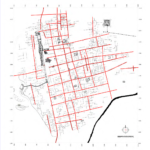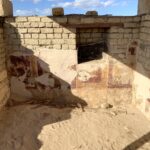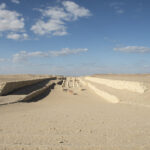MADĪNAT MĀḌĪ (NARMOUTHIS)
| Egyptian | Nw.t-Rnn.t |
| Greek | Ναρμουθις |
| Latin | Narmunthis |
| Coptic | narmoudi | narmoute | narmou+ |
| Arabic | مدينة ماضي |
| English | Medinet Madi | Kom Madi |
| DEChriM ID | 51 |
| Trismegistos GeoID | 1421 |
| Pleiades ID | 736972 | PAThs ID | 104 |
| Ancient name | Narmouthis |
| Modern name | Madīnat Māḍī |
| Latitude | 29.193372 |
| Longitude | 30.642546 |
| Date from | - |
| Date to | - |
| Typology | Village |
| Dating criteria | - |
| Description | The site of Madīnat Māḍī, also known as Narmouthis, is located in the Fayyum, north-west of the depression of el-Gharaq. It is 1 kilometer north of another archaeological area titled ‘Kom Māḍī’, a toponym which is sometimes used to reference both sites. As of yet, the relationship between the two is not completely understood. It has been hypothesised that Kom Māḍī was the Ptolemaic necropolis of Madīnat Māḍī, or perhaps that it was an autonomous entity alongside Madīnat Māḍī. Unfortunately, the quality of the archaeological work conducted, and the lack of stratigraphic information limits our capacity to establish a comprehensive summary of the developmental history of the site (Davoli 1998: 239). One of the main features of the site is a temple located at the northwestern end of the kom dedicated to the goddess Renenutet and the god Sobek of Shedet, the construction of which was initiated during the reign of Amenemhat III, and completed under his son, Amenemhat IV (12th Dynasty). This temple is denoted Temple A. It is uncertain as to whether there was already a town at the time the construction began, or if the town was developed when construction of the temple began. This earliest settlement was called Dja, and so-far, none of it has been identified, it is likely, however, that it was situated in the immediate vicinity of the temple. There are sporadic testimonies attesting to the continuous attendance of the temple until 3BC, including the addition of structures making up the north temple (Temple B), followed by additions on the south side (Davoli 1998: 228). At this time, Ptolemy II conducted a secondary period of land-reclamation, expanding or re-founding the settlement, now called Narmouthis. It is not known how extensive the inhabited area was at this time, but it appears to have extended so much so that the temple came to be located on the north-west edge of the city. At the end of the Ptolemaic period, an additional temple (Temple C) was constructed east of the temple complex comprising temples A and B. It is hypothesised that the number of inhabitants downsized in the fourth century CE, but the town still seems to have been of considerable importance considering the construction of a castrum in the eastern area of the site (housing Cohors IV Numidarum), and the number of churches located in the south-east area of the site, in the so-called ‘Coptic Area’. Proper investigation of this area was not initiated until 1984, under the direction of E. Bresciani. Two churches were unearthed in this season (CH 84A and CH 84B), understood to date from the fifth or sixth centuries. The following season, an additional church was identified in the same area (CH 85C) believed to have been constructed on-top of a Late Roman building. This too was understood to date to the fifth or sixth century (Bresciani 1986: 6). Three other churches were identified and partially excavated in in 1987 in collaboration with P. Grossmann (CH 87E, CH 87D and CH 87F) so-far uncovered and is understood to date from the fourth century. The following campaign saw the excavation of CH D87, and the investigation of two more churches (CH 88G and CH 88H), both of which are understood to date from the fourth to fifth centuries (Bresciani 1988; Grossmann 1988). Some ten churches have so-far been identified, indicating a high concentration of Christians at Narmouthis. The Christianness of the site is exemplified further through its connection with the production of a number of codices of the Monastery of the Archangel Michael. |
| Archaeological research | The site has been known since Napoleon’s expedition and was visited by Schweinfurth in 1886. The first fieldwork to be carried out, however, was not undertaken until 1900 by P. Jouguet, on behalf of the French Ministry of Public Education and the French institute in Athens. This mission, as can be expected, was not particularly scientific, and was conducted in an attempt to recover papyri, following the example of Grenfell and Hunt. The work carried out was more of an exploration rather than an excavation. A limited number of surveys were conducted at Kom Medinet Madi, concentrating on a Coptic church, yet there is no description of the building. This was followed by some very brief archaeological work undertaken by the Königlichen Museum in Berlin in 1910, directed by F. Zucker. The work started at the north-west extremity of the kom and revealed a considerable amount of 6th-8th century papyri, while sondages at the highest point of the kom revealed papyri dating from the second to the fourth century. To the west of this kom, in a long depression, Zucker identified limestone blocks supposed to be part of a temple. Work was cut short due to the ill-health of the workforce. No final report was ever published, however, the field diary was posthumously published by Müller in 1971. This was followed by the work directed by A. Vogliano, conducted between 1935 and 1939. Vogliano’s interest in the site was aroused by a number of Manichaean texts found by the Sebakhin which found their way to the antiquities market. At the time, Vogliano was participating in the archaeological mission of C. Anti in Tebtunis. Vogliano officially began work at Narmouthis on April 10th 1935, under the auspices of the State University of Milan in collaboration with G. Bagnanina. The work of the first mission resulted in the unearthing of the dromos of the temple identified by Zucker, which turned out to be dedicated to Renenutet/Ermouthis. The second excavation campaign was conducted the following year, with work concentrating in the northern part of the monumental complex unearthed the previous year which housed the aforementioned temple dedicated. A planimetric survey of the temple and associated complex was conducted by Naumann (1938), and an aerial photograph showed an additional, Ptolemaic temple situated to the north of the temple complex. The third campaign (1937) did not result in an official excavation report, only a brief report in Chronique d’Égypte 1938. The work of the season revealed a Middle Kingdom Temple and saw the beginning of work in the so-called Coptic quarter in the southern southern sector of the site. Unfortunately, nothing was ever published of the structures found. The fourth excavation campaign was conducted the following year and was concentrated on at least four different areas, one of which (north of the temenos) was revealed to be a portico of Corinthian columns 40 meters long dating from the Roman period. Vogliano’s excavations ceased as a result of the outbreak of the second world war, and work was not resumed until 1966, still conducted by the University of Milan, but now under the direction of E. Bresciani. Bresciani’s excavations revealed a housing sector to the east of the dromos, near some houses previously excavated by Vogliano in 1939. Preliminary reports of the 1968 and 1969 campaigns were published in a single volume in 1976. Excavations were interrupted between 1970 and 1975 due to the Arab-Israeli war, but resumed again in 1976, still under the direction of Bresciani, but now under the auspices of the University of Pisa. The Pisan mission, in conjunction with the University of Messina, uncovered a third temple (Temple C) in 1998, east of the temple complex comprising temples A and B, apparently dedicated to the worship of two crocodiles, perhaps Sokonopis and Sokopaio or Soknebtunis. The discovery of more than thirty crocodile eggs in a structure denoted ‘Annex II’ during the 1999 season led to the hypothesis that the building functioned as a nursery for sacred crocodiles. The season also saw the identification of two necropolises on the southwest side of the city. The first, understood to date from the Ptolemaic period, comprised pits cut in the sand and covered with regular limestone blocks, while the second, situated further to the south, included anthropoid terracotta sarcophagi. The work of the Pisan mission continued through the 2000s, with directorship shared between E. Bresciani and R. Pintaudi, before being handed to Pintaudi entirely. These missions have seen the identification of a ceramic (and perhaps a glass) factory in the south-eastern periphery of the city, and a Roman castrum in the north-east edge of the site, uncovered in 2006. The 2007 mission revealed a complex hydraulic system in the castrum. Various consolidatory and restoration work has been conducted, including that of the Institutional Support to Supreme Council of Antiquities for Environmental Monitoring and management of Cultural Heritage Sites (ISSEMM Project), official start-up in 2005, with on-site activities beginning in 2009. A team from the Trieste University Institute for Applied Geology, led by Michele Pipan, has also carried out a program of geophysical exploration of the site. |
• Bresciani, E. 1968. Rapporto preliminare delle campagne di scavo 1966 e 1967. Milano, Varese: Instituto Editoriale Cisalpino.
• Bresciani, E. 1975. “La dea-cobra che allatta il coccodrillo a Medinet Madi.” Aegyptus 55: 3-9.
• Bresciani, E. 1978. “L’attività archeologica in Egitto (1966-1976) dell’Istituto di papirologia dell’Università di Milano.” Qaderni de ‘La ricerca scientifica’ 100: 1-2, 16.
• Bresciani, E. 1980a. Kom Madi 1977 e 1978. Le pitture murali del cenotafio di Alessandro Magno. Pisa: Giardini.
• Bresciani, E. 1980b. “Le pitture murali del cenotafio di Alessandro Magno a Kom Madi nel Fayum.” Rendiconti dell’Accademia Nazionale de Lincei, VIII ser. 35. Rome, p. 73-84.
• Bresciani, E. 1982. “Attività archeologica dell’Università di Pisa in Egitto. Lavori a Saqqara: la tomba di pesceriteisu contigua all’ipogeo di Boccori: Scavi a Kom Madi nel Fayum: Il Kom Sud-Est.” In L’égyptologie en 1979. Axes prioritaires de recherches, 192-193. Paris: Éditions du Centre national de la recherche scientifique.
• Bresciani, E. 1984. “L’attività archeologica dell’Università di Pisa in Egitto (1984): Madinet Madi nel Fayum. Le chiese.” Egitto e Vicino Oriente 7: 1–7.
• Bresciani, E. 1986. “L’attività archeologica dell’Università di Pisa in Egitto (1985): Medinet Madi nel Fayum.” Egitto e Vicino Oriente 9: 7-14.
• Bresciani, E. 1987. “L’attività archeologica dell’Università di Pisa in Egitto (1987): Medinet Madi nel Fayum.” Egitto e Vicino Oriente 10: 1-5.
• Bresciani, E. 1988. “L’attività archeologica dell’Università di Pisa in Egitto (1988).” Egitto e Vicino Oriente 11: 1-11.
• Bresciani, E. 1989. “L’attività archeologica dell’Università di Pisa in Egitto: Kom Madi-Fayum (febbraio-marzo 1989).” Egitto e Vicino Oriente 12: 1-2.
• Bresciani, E., M. C. Betrò, W. Ferri, G. Nicola and G. R. Arosio. 1990. “L’attività archeologica dell’Università di Pisa in Egitto, a Saqqara (1989) e a Medinet Madi (1990).” Egitto e Vicino Oriente 13: 1-24.
• Bresciani, E. and D. Foraboschi. 1976. Missione di scavo a Medinet Madi (Fayum-Egitto). Milano, Varese: Istituto Editoriale Cisalpino.
• Bresciani, E. and A. Giammaristi. 1991. “Madīnat Māḍī.” In The Coptic Encyclopedia, vol. 5., edited by A. S. Atiya, 1497-1499. New York: Macmillan.
• Bresciani, E., A. Giammaristi, R. Pintaudi and F. Silvano. 2006. Medinet Madi. Venti anni di esplorazione archeologica, 1984-2005. Pisa: Università di Pisa.
• Bresciani, E., S. Pernigotti, M. C. Betrò, P. Gallo and A. Menchetti. 1983. Ostraka demotici da Narmuti I. Pisa: Giardini.
• Davoli, P. 1998. L’archeologia urbana nel Fayyum di età ellenistica e romana, 223-251. Napoli: G. Procaccini.
• Dittmann, K. H. 1941. “Der Segelwagen von Medînet Mâdi.” Mitteilungen des Deutschen Archäologischen Instituts. Abteilung Kairo 10: 60-78.
• Donadoni, S. 1947. “Testi geroglifici di Medinet Madi.” Orientalia 16: 333-352; 506-524.
• Donadoni, S. 1952. “Nuovi testi di Medinet Madi.” Prolegomena 1: 3-14.
• Donadoni, S. 1955. “Il greco di un sacerdote di Narmuthis.” Acme: Rivista della Facoltà di filosofia et lettere dell'Università statale di Milano 8: 73-83.
• Donadoni, S. 1988. “Le pietre di Medinet Madi.” In Pyramid Studies and Other Essays Presented to I. E. S. Edwards, edited by J. Baines, 61-67. London: Egypt Exploration Society.
• Ferri, W. 1989. “Rilievo topografico generale di Medinet Madi.” Egitto e Vicino Oriente 12: 3-19.
• Gallo, P. 1992. “The Wandering Personnel of the Temple of Narmuthis in the Faiyum and Some Toponyms of the Meris of Polemon.” In Life in a Multi-Cultural Society: Egypt from Cambyses to Constantine and Beyond, edited by J. H. Johnson, 119-131. Chicago: The Oriental Institute of the University of Chicago.
• Gallo, P. 1997. Ostraca demotici e ieratici dall’archivio bilingue di Narmouthis, vol. 2. Pisa: Edizioni ETS.
• Grossmann, P. 1987. “Medinet Madi – Die Kirche (1987). Beschreibung der Bearbeiten Kirchen.” Egitto e Vicino Oriente 10: 7-20.
• Grossmann, P. 1988. “Le chiese CH D87, CH G88 e CH H88 di Medinet Madi.” Egitto e Vicino Oriente 11: 13-23.
• Jouguet, P. 1905. “Fouilles du Fayoum : Rapport sur les fouilles de Médinet-Mâ'di et Médinet-Ghôran.” Bulletin de correspondance héllenique 25: 380-411.
• Timm, S. ed. 1984-1992. Das Christliche-Koptische Ägypten in Arabischer Zeit: Eine Sammlung Christicher Stätten in Ägypten in Arabischer Zeit unter Ausschyss von Alexandria, Kairo, des Apa-Mena-Klosters (Dēr Abū Mina), der Skētis (Wādi n-Naṭrūn) und der Sinai-Region. vol. 4: 1734-1738. Weisbaden: Dr Ludwig Reichert.
• Vogliano, A. 1938. “Rapporto preliminare della campagna di scavo a Madinet Madi.” Annales du Service des antiquités de l'Égypte 38: 533-549.


 Json data
Json data







